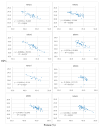Identification and Candidate Gene Evaluation of a Large Fast Neutron-Induced Deletion Associated with a High-Oil Phenotype in Soybean Seeds
- PMID: 39062671
- PMCID: PMC11276498
- DOI: 10.3390/genes15070892
Identification and Candidate Gene Evaluation of a Large Fast Neutron-Induced Deletion Associated with a High-Oil Phenotype in Soybean Seeds
Abstract
Since the dawn of agriculture, crops have been genetically altered for desirable characteristics. This has included the selection of natural and induced mutants. Increasing the production of plant oils such as soybean (Glycine max) oil as a renewable resource for food and fuel is valuable. Successful breeding for higher oil levels in soybeans, however, usually results in reduced seed protein. A soybean fast neutron population was screened for oil content, and three high oil mutants with minimal reductions in protein levels were found. Three backcross F2 populations derived from these mutants exhibited segregation for seed oil content. DNA was pooled from the high-oil and normal-oil plants within each population and assessed by comparative genomic hybridization. A deletion encompassing 20 gene models on chromosome 14 was found to co-segregate with the high-oil trait in two of the three populations. Eighteen genes in the deleted region have known functions that appear unrelated to oil biosynthesis and accumulation pathways, while one of the unknown genes (Glyma.14G101900) may contribute to the regulation of lipid droplet formation. This high-oil trait can facilitate the breeding of high-oil soybeans without protein reduction, resulting in higher meal protein levels.
Keywords: comparative genomics hybridization; fast neutron mutagenesis; renewable oil; triacylglyceride.
Conflict of interest statement
The authors declare no conflicts of interest.
Figures






Similar articles
-
Integrative omics analysis elucidates the genetic basis underlying seed weight and oil content in soybean.Plant Cell. 2024 May 29;36(6):2160-2175. doi: 10.1093/plcell/koae062. Plant Cell. 2024. PMID: 38412459 Free PMC article.
-
Genome-Wide Association and RNA-Seq Analyses Reveal a Potential Candidate Gene Related to Oil Content in Soybean Seeds.Int J Mol Sci. 2024 Jul 25;25(15):8134. doi: 10.3390/ijms25158134. Int J Mol Sci. 2024. PMID: 39125702 Free PMC article.
-
Identification and characterization of a fast-neutron-induced mutant with elevated seed protein content in soybean.Theor Appl Genet. 2019 Nov;132(11):2965-2983. doi: 10.1007/s00122-019-03399-w. Epub 2019 Jul 19. Theor Appl Genet. 2019. PMID: 31324928
-
Molecular mapping and genomics of soybean seed protein: a review and perspective for the future.Theor Appl Genet. 2017 Oct;130(10):1975-1991. doi: 10.1007/s00122-017-2955-8. Epub 2017 Aug 11. Theor Appl Genet. 2017. PMID: 28801731 Free PMC article. Review.
-
Understanding the Molecular Regulatory Networks of Seed Size in Soybean.Int J Mol Sci. 2024 Jan 24;25(3):1441. doi: 10.3390/ijms25031441. Int J Mol Sci. 2024. PMID: 38338719 Free PMC article. Review.
References
-
- Harwood J.L., Page R.A. Biochemistry of oil synthesis. In: Murphy D.J., editor. Designer Oil Crops. VCH; Weinheim, Germany: 1994. pp. 165–194.
-
- Flyckt K.S., Roesler K., Haug Collet K., Jaureguy L., Booth R., Thatcher S.R., Everard J.D., Ripp K.G., Liu Z.-B., Shen B. A Novel Soybean Diacylglycerol Acyltransferase 1b Variant with Three Amino Acid Substitutions Increases Seed Oil Content. Plant Cell Physiol. 2023;65:872–884. doi: 10.1093/pcp/pcad148. - DOI - PMC - PubMed
MeSH terms
Substances
Grants and funding
LinkOut - more resources
Full Text Sources
Miscellaneous

